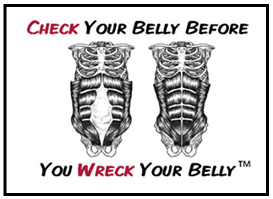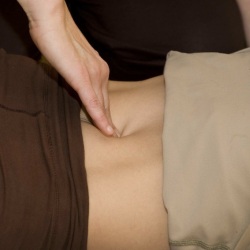Do you suffer with lower back pain? Do you have a protruding belly that won’t go away? Do you have an outie belly button that used to be an innie? Could you have separated abdominal muscles (Diastasis Recti)?
If you answered yes to any of the above then this article may help you.
What is Diastasis Recti?
Diastasis means separation (from the Latin) and recti refers to your rectus abdominis muscles (the most superficial muscles in the anterior abdomen, more commonly known as your abs.) So literally diastasis recti means that your abs have separated.
You have 4 layers of muscle in your anterior abdomen with the rectus abdominis sitting closest to the surface of your skin. Underneath it, in descending order, are the external obliques, internal obliques and the transversus abdominis. All four muscles play a part in holding the top half and the bottom half of your body together; providing support to the spine; containing the viscera (abdominal organs); and, allowing movement in the trunk.
Your rectus abdominis muscle runs down the center of your stomach, attaching at the breastbone and the pubic bone. It is known as a ‘twinned’ muscle because it consists of two halves, which lie on either side of the belly button. The two halves are enclosed and attached to each other by thin tendonous connective tissue known as the rectus sheath.
The lateral abdominal muscles (external obliques, internal obliques, transversus abdominis) wrap around the sides of the abdomen ending just near the edge of the rectus abdominis. Attached to the ends of all three muscles are tendonous expanses of connective tissue, known as the aponeuroses. These aponeuroses combine to form the rectus sheath. This connective tissue completely encloses the rectus abdominis and, where it meets at the midline, forms a horizontal line running directly down your stomach – this is known as the linea alba.

Causes of Diastasis Recti:
We are all born with our rectus abdominis separated but in most people they come back together somewhere around three years of age. However, the muscles are always susceptible to separating again if placed under continuous pressure or force.
Examples of pressure or force include:
- The growing uterus during pregnancy
- Weight gain in the abdominal area
- Incorrectly doing abdominal exercises
- Excessive intra-abdominal pressure (from lifting heavy weights, bearing down improperly when giving birth or voiding bowels.)
- Excessive coughing or sneezing
As a result diastasis recti can affect anyone – men, women – whether you have had children or not- and even children.

Health Risks of Diastasis Recti:
When you have diastasis recti the two halves of the rectus abdominis muscle have pulled laterally away from each other and the connective tissue between them – the linea alba- is stretched and becomes thin and weak. Because these muscles are part of the support system for your back and abdominal organs, when they separate this support system is compromised. The belly paunch that often accompanies diastasis recti is actually caused by your abdominal organs shifting forward into your stomach wall. Instead of being held in place by your abdominal muscles your organs are now being held in place by a weak, thin piece of connective tissue – a little like Glad Wrap.
Whilst Diastasis Recti is neither life-threatening nor dangerous, it can cause a variety of physical issues including:
- Lower back pain
- Pelvic instability
- Increased risk of developing a hernia
- Poor posture
- Tilted uterus
- Digestive issues
- A ’mummy tummy/ guy gut’ that no amount of diet or exercise will shift
The severity of your diastasis depends on how far the muscles have separated and how thin and weak the connective tissue has become.
Pregnancy and Diastasis Recti:
During pregnancy up to 70% of women will develop a diastasis. This is caused by the consistently increasing pressure of the growing uterus. In some women this separation will heal naturally post-partum but for most a degree of separation will remain and the linea alba will be weakened. During successive pregnancies this weakness will result in further separation and is also why many women ‘show’ quicker than they did with their first.
Developing or already having a diastasis during your pregnancy can impact you in several ways: As outlined a diastasis can increase back pain; affect pelvic stability; place pressure into the pelvic floor; and, in severe cases the uterus can tilt forward into the abdominal wall, putting the cervix out of alignment with the vaginal canal. This may make pushing the baby out vaginally much more difficult.
Indicators of a diastasis during pregnancy include but are not limited to:
1. your ‘innie’ belly button becomes an ‘outie’
2. you have a visibly distended ridge running down the midline of your stomach when doing a crunch, sit-up or when the spine is extended, as in a yoga backbending posture.
. . . . .
 From the desk of…
From the desk of…
Lana Dawkins & Stephanie Snelling
Creators of the “Repair Your Diastasis Recti” DVDs




